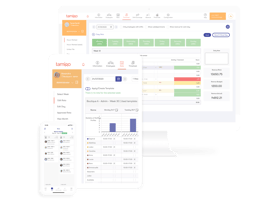Workforce management is a core function for businesses in every sector and of every size.
But what is it exactly? And where does workforce management software fit into the picture? Let’s dive in.
What is workforce management?
Workforce management (WFM) is a set of processes that optimise a business’s deployment of employees. In other words, it’s about making sure the right people, with the right skills, are in the right place, at the right time!
These are some of the processes involved:
- Employee scheduling
- Time and attendance
- HR management and reporting
- Forecasting and cost simulation
- Employee communication
- Payroll preparation
Workforce management as a unified concept gained traction in the late '80s and early '90s, in parallel with the emergence of the PC.
As computers became integral to business operations, it’s no surprise that one of Microsoft’s bundled programs — Excel — became the go-to place to track employees’ hours and performance.
Today, workforce management is a key tenant in any business growth strategy. Market Research Future valued the WFM market at EUR 6 billion in 2019. And it's estimated to reach EUR 19 billion by 2026.
So what about Excel? It certainly still has its uses, but businesses can no longer rely on it as their primary workforce management tool (but more on that later).
What can better workforce management achieve?
Why do companies focus on their workforce management?
Fundamentally, optimised workforce management can be a key driver in your long-term success.
It can:
- Reduce labour costs by avoiding over or understaffing
- Increase employee retention through clearer communication and flexible scheduling
- Save resources by streamlining countless administrative tasks
- Generate new insights into business performance
- Enable a new level of company-wide transparency around daily operations.
In highly competitive sectors like retail and hospitality, it makes all the difference.
This is especially true in today’s landscape, with businesses across Europe facing rising rents, supply chain and wholesale costs and a critical labour shortage.
Looking for a concrete example? Learn how outdoor sports brand Salomon modernised operations across 54 European stores.
What is workforce management (WFM) software?
Workforce management software gathers all your workforce processes into a single solution.
Some software, like tamigo, are cloud-based — available in both web and app versions, with nothing to install.
That means they’re accessible company-wide for every stakeholder, from employees behind the counter to the Head of Finance in HQ. Everyone is using the same system, working in the same way, and has access (depending on permissions) to the same data.
All the information about planned shifts, actual worked hours, in-store productivity and employee data is in the cloud. HR, operations, area managers and store managers can instantly see when information is missing. Or when something doesn’t look right from a performance or productivity viewpoint.
Jakob Toftgaard, CEO and founder, tamigo
Furthermore, you can easily integrate your existing IT systems too, creating a seamless flow of operations data. tamigo integrates with your payroll, HR, POS or ERP software — through ready-made plugins or our open API.
 What are the benefits of workforce management software?
What are the benefits of workforce management software?
We’ve talked about what WFM software is. But what are the actual concrete benefits? Here’s five to get started with:
1. Put an end to scheduling chaos
Staff schedules created in Excel quickly become outdated. All it takes is for one employee to call in sick or swap shifts with someone else, and the whole puzzle starts all over again.
Cloud-based schedules ensure that the most up-to-date information is available in one place and to all employees.
2. Digitise processes and empower employees with self-service
With a digital and smart WFM, tedious planning and approval processes are a thing of the past. Employees can access their schedule themselves, swap shifts with each other and request absences.
3. Communicate in real time
Are you planning a store event at short notice? Or is your next big sale on the horizon? In the past, communicating this to your workforce would involve numerous meetings, emails and calls.
WFM Software lets you to communicate directly via the platform, making relevant decisions transparent and increasing employee engagement.
4. Monitor and maximise KPIs
Foot traffic is subject to daily and seasonal fluctuations. Your operational planning should reflect this.
WFM software empowers planners to optimise operations with intelligent benchmarking across departments and locations. Simply import existing footfall data and see in advance if there are any staffing gaps.
5. Break data out of silos
Using different systems means that data is scattered. Anyone in charge of analysing company-wide performance endures the time-consuming process of requesting and checking information from every team.
With WFM software, this data is centralised. The result? Easier collaboration and smarter, data-backed decisions.
Further reading: 3 reasons to automate your workforce management.

Retail and hospitality workforce management software
Every type and size of business benefit from modernising workforce-related processes. But WFM solutions are especially indispensable for companies which have the following:
- Multiple locations (national or international)
- A shift-based workforce
- Experience fluctuating demand throughout the year
According to consulting firm Gartner, "45% of large companies with hourly paid employees and varying workforce needs will use automation [by 2025] to improve workforce planning decisions."
That’s why tamigo was designed for larger retail and hospitality businesses.
Our first ever customer was the restaurant chain Sticks’n’Sushi. Since then we’ve expanded to customers across Europe. Brands like McDonald's, Coop, Bijou Brigitte and Salomon use tamigo every day to grow their business.
Learn more about WFM software
Is your company considering a solution? We’ve got just the guide for you.
Inside you’ll find:
- The benefits businesses are reaping from workforce management systems. Optimised staff costs, higher employee engagement and more.
- What your company needs to look for when shopping different vendors.
- A detailed look at implementation. How long does it take, and which stakeholders need to be involved?






